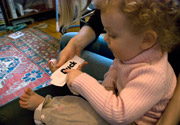

A couple of weeks ago we tried a little experiment to teach our toddler to read. We were astounded by the results, so have decided to follow through and it looks like she is going to be reading before she is 2 years old. We continue to outline our methods and results and hope other parents will help us refine the techniques.

During the first week Amélie had learned to recognise about 5 words. We can't believe how much progress she has made since then. We play the game about 4 times a day and add an average of 1 word per day. She is now up to 17 words, and would typically get all 17 correct but 2 or 3 answers would be second attempts. By second attempts I mean she reads incorrectly and we ask her again and she gets it correct.
During the first 10 days she didn't always want to play. We started giving her a grape after each game which made her much more enthusiastic. She still has a lot of Easter eggs left, so we broke one up and gave her a little bit after each game. Obviously this was a dumb move on our behalf as the grapes don't do it for her anymore!
The main game is to go through the cue cards and read each word. Another game is to lay the words out and ask her to pass each one to us. The first week she got none correct and just collected random words and gave them to us. Sometimes she would grab a lot of words and hand them to us. Now though we are getting better results but not close to the success of just reading through card by card.
We play the second game much less often as we don't want Amélie to lose heart or get bored. She loved the first game and claps herself so we feel it's much better to stick to that for now and build her confidence.

Another new aspect we introduced was using different fonts. I showed Amélie a word she had already learned but in a different font. The first I chose was 'Bear' as it was the first word she learned and she was very good at that particular word. I half expected her to get it correct but she didn't. I then tried her with 'Cat' and she didn't get that either. 2 days later she could read 'Cat' and 'Bear' in both fonts correctly.
A real test would be if she could identify correctly, a word in the second font which she had only learned in the first font. Before writing this article I tested her with 'Bee' in the new font and she said 'Bear' I gave her a couple of attempts but she didn't get it correct. I didn't give her the correct answer as I want to try again in a few days. So at this point she can't translate between fonts on her own, but when told only once she can read both.
I find this odd because just over a week ago she had been able to read words that we wrote on the blackboard. Surely it's the same skill. Perhaps it was because back then she only knew 4 or 5 words and now she has a bank of 17 words that she has learned.
Something else to mention is how she learns new words. I pick up a new word from the mantelpiece and she runs over to me. I show her the word and wait a few seconds in the hope that miraculously she will read it without being told. Obviously she never has. Then I repeat the word a few times and hand it to her. She repeats the word and then often if it is an object in the room she will run over and label that object.
When we gave her 'Book' she went over to the bookshelf and put it on a book and said 'Book'. When we gave her 'Hot' she went to the radiator and held up the word next to it and said 'Hot'. This is all we do and she now knows that word. We never have to tell her again, even the next day she will be able to read the new word without being told. It takes less than 20 seconds for her to learn the word.
Something else to note is on the rare occasion she reads a word incorrectly you can usually see why she has made the mistake. Often the word has the same first or last letter as the one she mistakes it for.
We are making the rules up as we go along, and will keep posting articles documenting our progress.